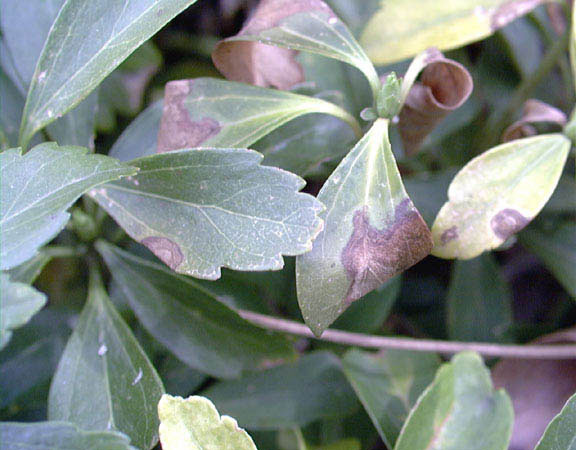
Early symptom of boxwood blight. Photo courtesy Connecticut Department of Agriculture
A worrisome new fungus found on boxwoods also threatens Japanese spurge, the popular ground cover, according to Purdue University’s Plant Pest Diagnostic Laboratory.
Boxwood (Buxus) blight (Cylindrocladium pseudonaviculatum) has been confirmed in Ohio, North Carolina, Connecticut, Virginia, Maryland, Pennsylvania, New York, Rhode Island, Massachusetts and Oregon. The same fungus recently was found to cause the disease on Japanese spurge (Pachysandra terminalis). The disease was first reported late last year in Connecticut, where the disease was found on boxwoods in a residential landscape. In the other states and Canada, the blight has been found on boxwoods at nurseries and growers.
Although boxwood blight has not been found in Indiana, the Purdue plant experts recommend that property owners and landscapers be vigilant if planting new boxwoods or Japanese spurge in landscapes this spring. The Purdue lab asks to be contacted if you see symptoms on boxwoods or Japanese spurge.
“Recently, plant pathologists at the Connecticut Agricultural Experiment Station found that the fungus, which causes boxwood blight, can also cause disease on Pachysandra ground cover,” the Purdue lab reported March 19, 2012. Japanese spurge (Pachysandra terminalis) is part of the boxwood family.
The Connecticut research exposed healthy pachysandra plants to the spores of the fungus and within 10 days, lesions or small round spots developed. Three weeks after exposure, “many of the leaves with lesions yellowed and dropped,” the Purdue lab said. “This raises significant concerns about pachysandra as a potential source of (the spores) for infection of boxwood and vice versa.”
The leaf spot and dieback symptoms on the spurge may be confused with a common and widespread disease of Pachysandra, known as Volutella blight (see photo below).

Volutella blight on Japanese spurge (Pachysandra terminalis). Photo courtesy Purdue University Plant Pest Diagnostic Laboratory
Hi Jo Ellen,
This is very interesting. I wonder if it’s likely to affect existing boxwood and pachysandra plantings. I didn’t know they were related. I have some really mature and healthy boxwood in three places in my garden, and I’ll be checking them carefully now. Thanks for the info!